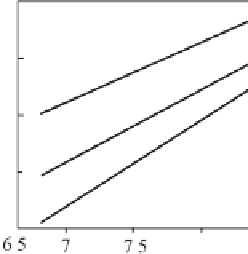Geoscience Reference
In-Depth Information
Fig. 3.1 Earthquake energy
(1), energy of gravitational
tsunami wave (2) and energy
of elastic waves in water (3)
versus earthquake magnitude
(J)
M
several percent of the earthquake energy can be transferred to elastic waves. Thus,
submarine earthquakes are capable of exciting powerful acoustic waves, and no-
ticeable manifestations are to be expected of the effect of water compressibility in
the case of tsunami generation.
Further we shall consider the mathematical model of a compressible water col-
umn under the assumption of an absolutely rigid ocean bottom. Such an assump-
tion simplifies the problem noticeably and permits to concentrate on manifestations
of the compressibility of the water column. A realistic formulation of the prob-
lem should, naturally, take into account the elasticity properties of the ocean bot-
tom. The problem, thus formulated, was first considered by G.S. Pod'yapolsky
[Pod'yapolsky (1968a, b), (1978)]. This topic was further developed in analyti-
cal studies [Gusyakov (1972), (1974)], [Alexeev, Gusyakov (1973)], [Zvolinsky
(1986)], [Zvolinsky et al. (1991), (1994)] and [Sekerzh-Zen'kovich et al. (1999)].
In recent years publications have appeared, in which attempts are made of numer-
ical simulation of the dynamics of a compressible water column with account of
the elasticity properties of the ocean bottom [Panza et al. (2000); Ohmachi (2001)].
In particular, these properties will be manifested in the time interval, during which
elastic oscillations of a water column exist, being limited owing to 'leakage' of en-
ergy into the ocean bottom.
Consider elastic oscillations to be caused by a horizontally homogeneous verti-
cal deformation of the ocean bottom, taking place within quite an extended area.
Then the problem becomes one-dimensional along the vertical coordinate. We write
the evolution equation for the energy
W
of elastic waves contained in a water column
of thickness
H
as
W
τ
s
.
The energy
W
obviously decreases exponentially with time. The quantity
d
W
d
t
=
−
τ
s
,
characterizing the damping time, can be deduced from the following arguments.
During the propagation of an elastic wave from the ocean bottom to the sur-
face and back (2
H
/
c
) its energy will be reduced by the quantity
D
0
W
, where
D
0
= 4
ρ
b
c
b
)
−
2
is the transition coefficient at the 'water-bottom'
boundary for a normally incident elastic wave,
ρρ
b
cc
b
(
ρ
c
+
ρ
b
and
c
,
c
b
are the densities of and
elastic wave propagation velocities in water and the ocean bottom rock, respectively.
ρ
,








